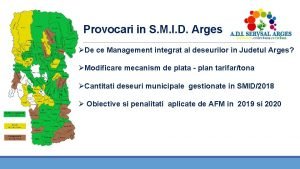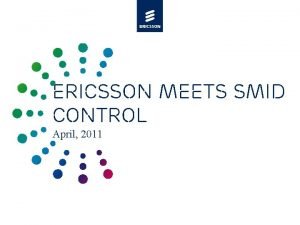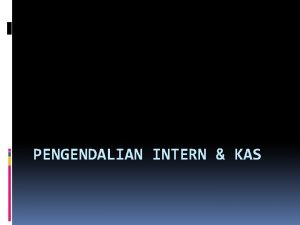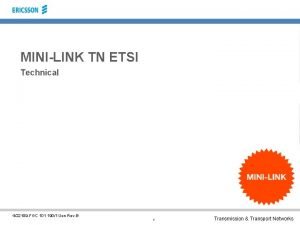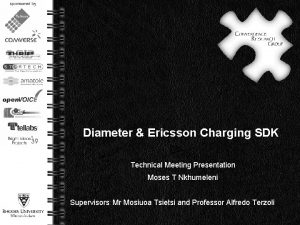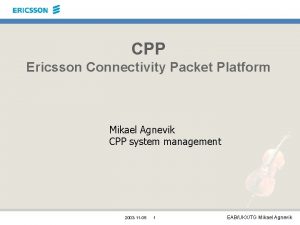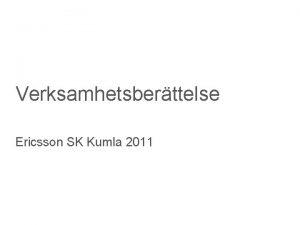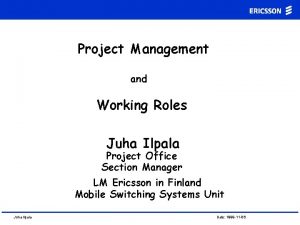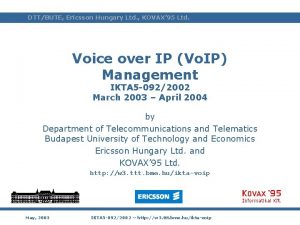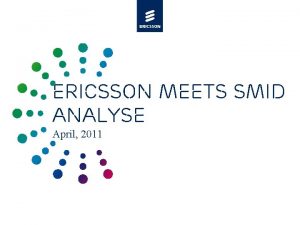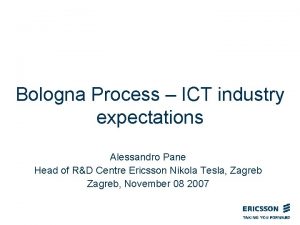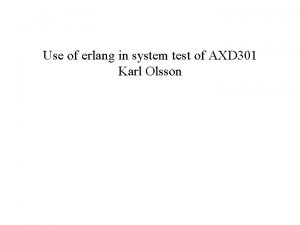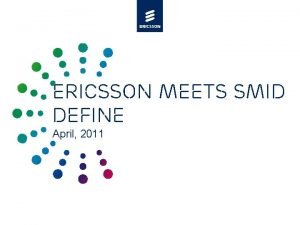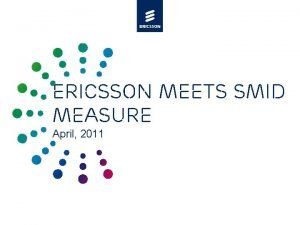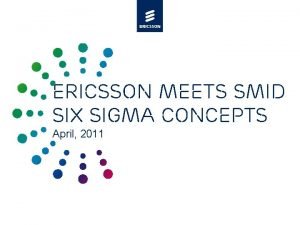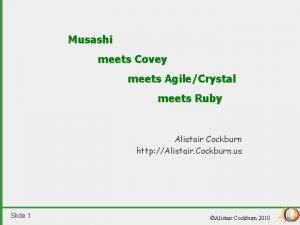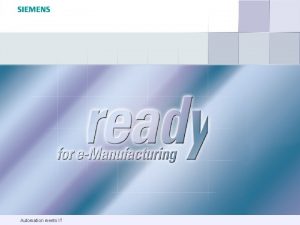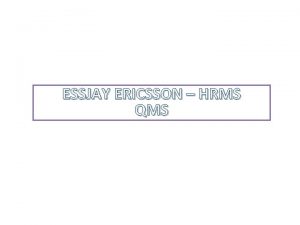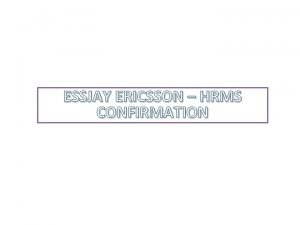ERICSSON MEETS SMID CONTrol April 2011 Agenda 4

















- Slides: 17

ERICSSON MEETS SMID CONTrol April, 2011

Agenda › 4 th April – Ericsson presentation – Statistical tools in manufacturing – DMAIC/IDDOV › 7 th April – Define – Measure › 11 th April – Analyze › 14 th April – Implement – Control Ericsson @ SMID - Control | Commercial in confidence | 2011 -04 -04 | Page 2 (24)

DMAIC Chart Comprehensive Light D efine M easure A nalyze I mprove C ontrol Understand the task and its financial impact. Develop and execute an appropriate data collection method. Find the root causes. Generate and implement solutions. Ensure that the results will last. • Task selection matrix • SMART review • Stakeholder map • Risk Management • Process map • Data collection table • Pareto diagram • Fishbone diagram • Correlation analysis • FMEA risk analysis • Process map • Documentation, standardization and training • SWOT analysis • Process map • VOC and break down to CTQs • 7 MT • Affinity diagram • 7 QCT • Measurement system analysis • Sampling technique • SIPOC • Gauge R&R, Gauge attribute • Capability analysis • Benchmark • Tagushi loss functions • 7 QCT • Hypothesis testing • Regressionanalysis • DOE • Anova • 7 MT • Data transformations • Simulations • Poka-Yoke • Hypothesis testing • Loss functions • Cost/Benefit selection • Pugh Concept Selection • 7 QCT • SPC • Business case verification Ericsson @ SMID - Control | Commercial in confidence | 2011 -04 -04 | Page 3 (24)

BUSINESS CASE VALIDATION

Show me the money!! What was the financial benefit of this improvement? Both costs and savings • Hard savings • Soft savings • Project cost • Investments • Etc. Ericsson @ SMID - Control | Commercial in confidence | 2011 -04 -04 | Page 5 (24)

MAKE THE IMPROVEMENT LAST

SPC STATISTICAL PROCESS CONTROL

Different stories? › Manager: “ Hey, I made my decision based on data - How can I go wrong ? ” › Yellow Belt: “Your decisions were made from observing high and low points as signals. When in reality, it was all noise. Look at the data, there was no significant change in the process. ” Manager concludes, “Tough Love Makes Things Happen!” UCL Scrap Level (%) 3 2 1 LCL J F M A M J J A S O N D 1996 Party Time J F M M J J A S O 1997 Manager Wants To Take Back Award Ericsson @ SMID - Control | Commercial in confidence | 2011 -04 -04 | Page 8 (24) No more soft management

Control Limits vs Specification Limits › Control limits are calculated from process data for a particular control chart. – Typical limits are 1 , 2 , and 3. With values falling outside these "standard limits", standardized rules can be used to assess whether the process is out of control › Specification limits are chosen in numerous ways. They generally apply to the individual items being measured and appear on histograms, box plots, or probability plots. – Limits are set based on what is tolerable by customers, is costefficient to maintain, etc Ericsson @ SMID - Control | Commercial in confidence | 2011 -04 -04 | Page 9 (24)

Control Chart types Measurement data Continuous data 1 2 3 4 Discrete data A: B: C: 5 Attributes (yes/no) ? Counts ? ? Subgroup size constant and equal to 1 Subgroups constant Subgroup size changes Subgroup size constant Subgroup size changes Individuals charts or I-MR charts X-S charts NP charts C charts U charts Continuous Pass/fail Ericsson @ SMID - Control | Commercial in confidence | 2011 -04 -04 | Page 10 (24) Number of faults

Causes › COMMON CAUSE (Noise) – Is present in every process – Is produced by the process itself (The Way We Do Business) – Can be removed and/or lessened but requires a fundamental change in the process › SPECIAL CAUSE (Signals) – Exists in most operations/processes – Caused by unique disturbances or a series of them – Can be removed/lessened by basic process control and monitoring Ericsson @ SMID - Control | Commercial in confidence | 2011 -04 -04 | Page 17 (24)

Chart Description Process In Control Chart points do not form a particular pattern AND lie within the upper and lower chart limits. Example #1 UCL Process Out of Control Run Trend Cycle Chart points form a particular pattern OR one or more points lie beyond the upper or lower chart limits. Chart points are on one side of the center line. The # of points in a run is called the length of the run. A continued rise or fall in a series of points (7 or more consecutive points in the same direction). Example #2 UCL 20 LCL 10 UCL 20 20 15 1 2 3 4 5 6 7 LCL 10 UCL 20 15 LCL 10 UCL 20 Chart points show the same pattern changes (e. g. , rise or fall) over equal periods of time. 15 15 LCL Suggests the process has undergone a permanent change (+ or -) and is now becoming stable. Often requires that you recompute the control lines for future interpretation efforts. 15 15 UCL Alerts you that the process is changing. Doesn’t mean you need to take corrective action. May be related to a change you have made. Be sure to identify the reason(s) before taking any constructive action(s). 15 15 10 The process is stable, not changing. Doesn’t necessarily mean to leave the process alone. May be opportunities to improve the process and enjoy substantial benefits. 20 15 15 LCL Interpretation 10 Ericsson @ SMID - Control | Commercial in confidence | 2011 -04 -04 | Page 18 (24) LCL 10 1 2 3 4 5 6 7 Often seen after some change has been made. Helps tell you if the change(s) had a + or effect. May also be part of a learning curve associated with some form of training. Often relates to factors that influence the process in a predictable manner. Factors occur over a set time period and have +/- effect. Helps determine future work load/staffing levels.

Control Chart Rules One point outside the UCL or LCL Six points in a row, all increasing or decreasing Ericsson @ SMID - Control | Commercial in confidence | 2011 -04 -04 | Page 19 (24) Nine points in a row on same side of center line Fourteen points in a row, alternating up and down

SPC, I-MR chart › The data we have are process times for one product. › Can we control the process and know when to react? Ericsson @ SMID - Control | Commercial in confidence | 2011 -04 -04 | Page 20 (24)

SPC, Xbar-S chart Ericsson @ SMID - Control | Commercial in confidence | 2011 -04 -04 | Page 21 (24)

SPC, P-Chart › In the factory X Quality department perform audits (QA) on all products every week and present the result for management. › How should they react and when if the target are 5%? Ericsson @ SMID - Control | Commercial in confidence | 2011 -04 -04 | Page 22 (24)

Ericsson @ SMID - Control | Commercial in confidence | 2011 -04 -04 | Page 24 (24)
 Smid
Smid April ericsson
April ericsson Pada tanggal 1 april 2011 cv seneng makmur
Pada tanggal 1 april 2011 cv seneng makmur Agenda sistemica y agenda institucional
Agenda sistemica y agenda institucional Ericsson minilink hc
Ericsson minilink hc Prototyp telefonu komórkowego
Prototyp telefonu komórkowego Essjay ericsson web portal
Essjay ericsson web portal Ericsson diameter sdk
Ericsson diameter sdk Cpp ericsson
Cpp ericsson Ericsson for me
Ericsson for me Utd ecs advising
Utd ecs advising Props project management
Props project management Ericsson hungary
Ericsson hungary Ericsson analys
Ericsson analys Alessandro pane ericsson
Alessandro pane ericsson Sahix
Sahix Ericsson.se
Ericsson.se Ericsson innovation awards 2018
Ericsson innovation awards 2018
